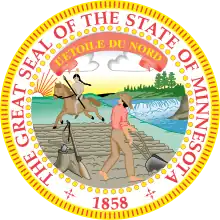2008 Minnesota Democratic presidential caucuses
The 2008 Minnesota Democratic presidential caucuses took place on Super Tuesday, February 5, 2008 with 78 delegates at stake. The winner in each of Minnesota's eight congressional districts was awarded all of that district's delegates, totaling 47. Another 25 delegates were awarded to the statewide winner, Barack Obama. The 72 delegates represented Minnesota at the Democratic National Convention in Denver, Colorado. Sixteen other unpledged delegates, known as superdelegates, also attended the convention and cast their votes as well.
| |||||||||||||||||||
| |||||||||||||||||||
 Caucus results by county Clinton: 40–50% 50–60% 60–70% Obama: 40–50% 50–60% 60–70% 70–80% | |||||||||||||||||||
| Elections in Minnesota |
|---|
 |
Candidates
Candidates Joe Biden, Chris Dodd, Dennis Kucinich, Bill Richardson, and John Edwards dropped out of the presidential race before the Minnesota Democratic Caucus.
Money Raised from Minnesota
| Candidate | Money raised[1] (US$) |
|---|---|
| Joe Biden | $11,290 |
| Hillary Clinton | $630,361 |
| Chris Dodd | $63,130 |
| John Edwards | $218,697 |
| Mike Gravel | $500 |
| Dennis Kucinich | $9,640 |
| Barack Obama | $614,569 |
| Bill Richardson | $82,094 |
Process
Of the 88 delegates, 72 were allocated based on the results of the caucuses. Candidates were required to reach a threshold of 15 percent support at the precinct, congressional district, and statewide levels. Unlike other caucuses, there was no realignment of nonviable groups, and the results were binding for the delegates.[2]
In 2008, there were more than 4,000 precinct caucus sites. Any Minnesotan who would be eligible to vote in the November general election, was not an active member of a party other than the Democratic-Farmer-Labor Party, and agreed with DFL party principles was allowed to participate. All participants, by signing in, affirmed their agreement with the DFL's principles. The caucus included a presidential preference primary, in which voters cast secret ballots for presidential candidates. These results were tallied and used to elect 47 delegates from each of the state's eight congressional districts as follows:[2]
| Congressional District |
Pledged Delegates |
|---|---|
| 1st | 5 |
| 2nd | 5 |
| 3rd | 6 |
| 4th | 7 |
| 5th | 8 |
| 6th | 5 |
| 7th | 5 |
| 8th | 6 |
| Total | 47 |
An additional 25 pledged delegates were then allocated based upon the statewide caucus vote.[2] Sixteen of these delegates were allocated for Barack Obama while nine were allocated for Hillary Rodham Clinton.
The remaining 16 delegates were unpledged superdelegates. The 14 Democratic Party Leaders and Elected Officials (PLEOs) included seven Democratic National Committee members, six members of the United States Congress, and former Vice President Walter Mondale. There were also two unpledged add-on delegates, elected at the Minnesota Democratic-Farmer-Labor Party State Convention.[2]
Pre-Caucus Events, Predictions, and Polls
Polling showed a tightening race for the nomination.
| Candidate | Sept. 18–23, 2007[3] | Jan. 18–27, 2008[4] |
|---|---|---|
| Hillary Clinton | 47% | 40% |
| Barack Obama | 22% | 33% |
| John Edwards | 16% | 12% |
Caucus Night
Minnesotans turned out in record numbers to attend the 2008 Democratic Caucuses in locations throughout the state. The previous record turnout was about 80,000 in 1968 or 1972; the 2008 turnout exceeded 214,000. As the caucus results came in, Barack Obama consistently held a two-to-one lead over Hillary Rodham Clinton with strong support all throughout the state.[5][6] Turnout at the Democratic Caucuses was significantly higher than at the Minnesota Republican Caucuses that night.
Following the results of the Super Tuesday elections, U.S. Senator Amy Klobuchar endorsed Barack Obama.
Results
| 2008 Minnesota Democratic Presidential Caucus Results | ||||||
|---|---|---|---|---|---|---|
| Party | Candidate | Votes | Percentage | Delegates | ||
| Democratic | Barack Obama | 142,109 | 66.39% | 48 | ||
| Democratic | Hillary Clinton | 68,994 | 32.23% | 24 | ||
| Democratic | Uncommitted | 1,312 | 0.61% | 0 | ||
| Democratic | John Edwards | 985 | 0.46% | 0 | ||
| Democratic | Dennis Kucinich | 361 | 0.17% | 0 | ||
| Democratic | Joe Biden | 129 | 0.06% | 0 | ||
| Democratic | Bill Richardson | 82 | 0.04% | 0 | ||
| Democratic | Christopher Dodd | 77 | 0.04% | 0 | ||
| Democratic | Frank Lynch | 17 | 0.01% | 0 | ||
| Totals | 214,066 | 100.00% | 72 | |||
| Voter turnout | % | — | ||||
See also
References
- "Map: Campaign money race". CNN. January 7, 2008. Retrieved February 5, 2008.
- "Precinct Caucus Frequently Asked Questions: National Delegate Selection". Minnesota Democratic-Farmer-Labor Party. Archived from the original on April 13, 2008. Retrieved January 28, 2007.
- "Minnesota Poll: Clinton has strong lead, but GOP race is bunched up". Star Tribune. October 2, 2007. Archived from the original on January 10, 2008. Retrieved February 3, 2008.
- "Minnesota Public Radio News and Humphrey Institute Poll" (PDF). Center for the Study of Politics and Governance, Humphrey Institute of Public Affairs, University of Minnesota. January 29, 2008. Retrieved February 3, 2008.
- Stassen-Berger, Rachel E. (February 6, 2008). "Nearly 200,000 turn out in Obama victory". St. Paul Pioneer Press. Retrieved February 6, 2008.
- "Unofficial Results Presidential Preference Ballot / Democratic-Farmer-Labor Party Results". Minnesota Secretary of State. Archived from the original on February 13, 2008. Retrieved February 15, 2008.
External links
- League of Women Voters of Minnesota Information on caucuses and voting
- Minnesota Public Radio, Campaign 2008: Presidential Race Campaign news and polls
- Minnesota Democratic-Farmer-Labor Party Detailed caucus information

